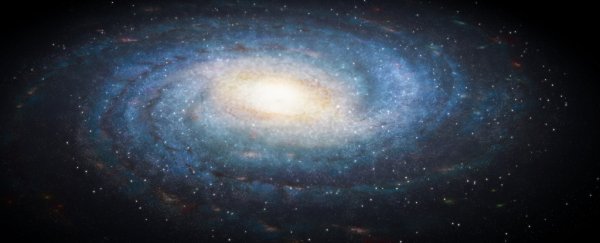When you're swimming in a large body of water, calculating its volume or discerning the locations of distant floating objects isn't easy. The same is true for our galaxy.
From our position inside the Milky Way, much of its size, contents, and three-dimensional structure is really tricky to figure out. There's a lot that eludes us, or is impossible to calculate; even so, every now and again, a discovery comes along that makes you wonder, how in the heck did we miss that?!
A newly discovered structure named the Cattail is just such a wonder. It's a long curl of gas that's so large, astronomers aren't sure whether or not it might actually be part of a galactic spiral arm that we never noticed until now.
Even if it isn't the sign of an unmapped spiral arm, the Cattail may be the largest filament of gas in our galaxy discovered to date. It's been described in a paper accepted to The Astrophysical Journal Letters, available on preprint server arXiv.
The structure "appears to be so far the furthest and largest giant filament in the galaxy," a team of astronomers from Nanjing University in China writes in the paper.
"The question about how such a huge filament is produced at the extreme galactic location remains open. Alternatively, Cattail might be part of a new arm … though it is puzzling that the structure does not fully follow the warp of the galactic disk."
There are several reasons it's hard to map the Milky Way in three dimensions. One of them is that it's very tricky to work out the distances to cosmic objects. Another is that there is a lot of stuff out there, so it can be hard to know if something is a significant grouping or just a random collection spread out along a line of sight.
To identify the Cattail, a team led by Nanjing University astronomer Chong Li used the huge Five-hundred-meter Aperture Spherical radio Telescope (FAST) to look for clouds of neutral atomic hydrogen (HI). Such clouds are usually found in the spiral arms of galaxies like ours; by studying subtle differences in the hydrogen's light, it's possible to map the number and arrangement of the Milky Way's arms from within.
In August 2019, the researchers used FAST to look for HI radio emissions, and the data revealed what appeared to be a large structure. When they calculated how fast the structure was moving, they got a surprise: its velocity was consistent with a distance of around 71,750 light-years from the galactic center - the outer regions of the galaxy.
That distance - farther than any known spiral arms in that region of the galaxy - would mean the thing is absolutely huge, with a size of around 3,590 light-years in length and 675 light-years in width, based on the FAST data.
But then, when the researchers combined their findings with data from the HI4PI all-sky HI survey, they found that it could be even larger still - as much as around 16,300 light-years in length.
That would make it even more colossal than the gas structure known as Gould's Belt, which was recently found to be 9,000 light-years long.
The Cattail raises some interesting questions. Most gas filaments occur much closer to the galactic center, and are associated with spiral arms. If it's a filament, it's unclear how the Cattail could have formed and remained out beyond the known spiral arms of the Milky Way.
On the other hand, if it's a spiral arm, that's also peculiar. The galactic disc of the Milky Way is wobbly and warped from an encounter with another galaxy, a long time ago. Yet the Cattail's shape does not entirely conform to this warp - which it should do if it was a spiral arm.
Even if the discovery wasn't already fascinating, these peculiarities indicate that we might want to take a closer look at this amazing structure.
"While these questions remain open with the existing data," the researchers wrote, "the observations provide new insights into our understanding of the galactic structure."
The research has been accepted into The Astrophysical Journal Letters, and is available on arXiv.
